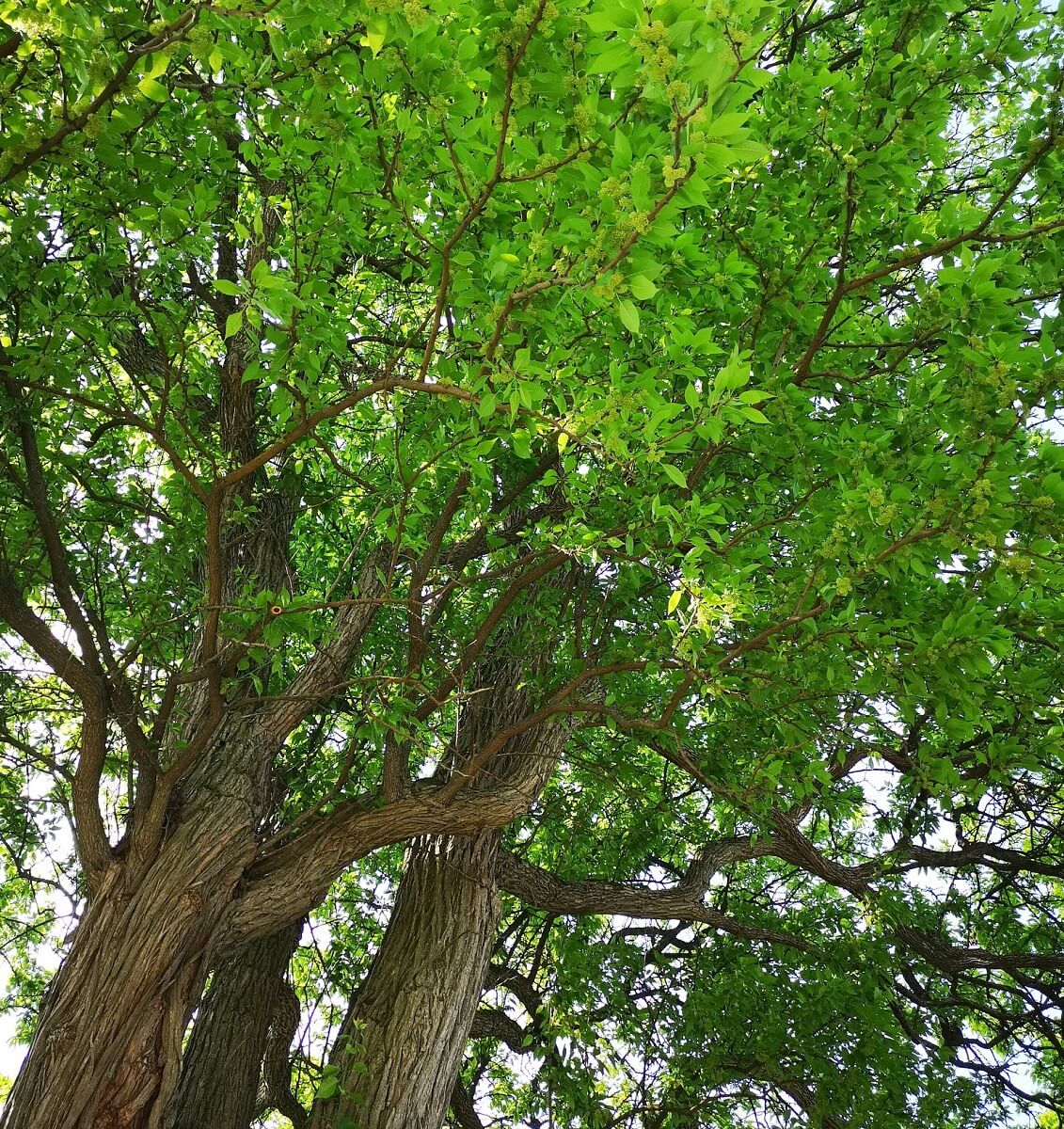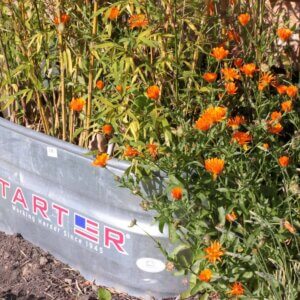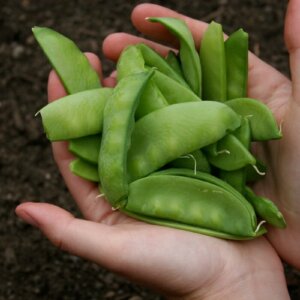Grown for decades by farmers and gardeners across the mid-western United States, Osage orange trees are incredibly versatile and can serve all sorts of purposes on the homestead. The wood from the Osage tree has been used to make tool handles, fence posts, livestock stockades, and furniture with a stable, durable wood that can withstand rot for many years.

In some places, 50-year-old fence posts still stand strong and sturdy as new. Did you know that Osage orange is the hardest wood grown in North America?
Also known as hedge-apple, horse-apple, Naranjo chino hedge, or bois d’arc, the Osage orange tree (Maclura pomifera) has a short, sturdy trunk and a large rounded canopy.
Osage Orange Tree Characteristics
A small to medium-sized deciduous tree, the Osage orange tree reaches a mature height of 30 to 40 feet tall with a 40-foot broad, arching crown. A vigorous, fast-growing tree, Osage orange can even become invasive in ideal growing conditions. During summer, the oval-shaped, 5- to 7-inch leaves are a brilliant green, turning golden yellow in autumn. The branches tend to be thorny.

The leather-like solid leaves do not wilt or turn brown in the hot, dry days of summer. As a landscape focal point, Osage orange trees offer a vibrant, bright pop of color, when most other foliage has turned brown and withered.
Related Post: Planting, Growing, And Maintaining Chestnut Trees
Female trees produce large globular greenish-yellow fruit; hence the name Osage orange or hedge-apples. The ball-shaped fruit reaches sizes from 5 to 7 inches in diameter. The hard-skinned fruit has a surface texture that resembles a green brain: warty, bumpy, and covered with fine hairs.

Osage orange is especially prevalent throughout the Great Plains region of the United States, and adapts to a diverse range of soil conditions: rocky, sandy, organic, clay, acidic, or alkaline. Tolerant of heavy moisture or drought conditions, the hardy tree flourishes far beyond its native range.
Osage Orange Trees as Ornamentals
As settlers migrated west, establishing homesteads and frontier farms, Osage orange was a highly prized timber source valued for the sturdiness of the wood. Osage orange trees planted 3 to 4 feet apart, grew quickly within three or four years to form an impenetrable vegetative fence.
To add additional strength to the green barrier, many homesteaders wove the branches of adjoining trees together to make extra strong livestock enclosures.
As an ornamental specimen, the Osage orange tree offers year-round visual interest with spring flowers and bold gold color in the fall. Both the male and female tree produce small creamy white flowers, but only the female tree produces fruit. The height and arching form of the tree, complemented by its unique shape and unusual textured orange-colored bark, provides winter interest.

A member of the mulberry family and a close cousin of the fig and breadfruit tree, Osage orange is especially tough. It’s tolerant of periodic drought or flooding, disease, insects, and is able to survive in almost any soil. Osage orange flourishes in USDA Hardiness Zones 4 to 9 and does best in a full sun location with good drainage. Osage orange does not do well in swampy areas with standing water.
Osage Oranges: Food for Wildlife
Although humans find the fruit inedible, the citric scented orbs are a favorite of small wildlife that tear apart the sweet and sticky fruit to access the highly nutritious seeds. The ugly fruit of the Osage orange tree is an aggregate fruit, much like its cousin the mulberry. It’s composed of numerous one-seed drupes.

The fruit of the Osage orange tree is not poisonous to livestock though horses and cattle tend to ignore it, deeming the fruit inedible due to its large size and unpalatable dry, hard texture.
Squirrels scamper through its branches, tearing apart the fruit to harvest the seed — which they enjoy as a special treat. Songbirds sing in its branches while upland game birds find food and shelter beneath its low hanging branches.
Osage Orange Gains New Popularity Among Homesteaders
Across the mid-western United States, Osage orange trees flourish along neglected and overgrown edges of fields, pastures, and old homesteads as scrub vegetation forgotten in the “far corners of the back-40.” Osage orange is also an excellent source of firewood.
Related Post: Fast-Growing Shade Trees For Your Homestead
Homesteaders of today, reclaiming old farms and homesteads, are cutting, clearing, burning, and pruning stands of hedge-apple or Osage orange to restore the trees original function and utility. Trimmings are retained for firewood, and many homesteaders wishing to embrace traditional ways, establish fences woven from Osage orange along property lines.
The sharp thorns of the Osage orange tree provide a deterrent to intrusion, and homesteaders never have to spend time mending fences. Osage orange presents a distinctive growth with its dense crown of thorny, interlacing branches that drape down and touch the soil, then root and send up vertical shoots. Homesteaders planting Osage orange to build a windbreak or livestock stockades note the tree’s ability to grow quickly is its greatest attribute.
Potential Pests and Problems
When first cut, Osage orange trees bleed a white, milky sap that serves as a glue or sealant. When handling cut pieces of the orange-colored wood, it is best to wear gloves as some people have an allergic skin reaction when exposed to the sap. Properties of the sap protect the wood from decay by killing soil-born organisms.
Osage orange trees are fast growing, drought tolerant, and virtually disease and pest free. However, interior branches of the tree tend to die, and persist in the interior of the canopy due to self-shading. Because the wood is impervious to rot, the branches do not deteriorate and fall.
Related Post: How To Get Rid Of Aphids
When utilized as a landscape tree, it is necessary to annually prune and remove dead wood to maintain the tree’s attractive form. The Osage orange tree also makes a bit of a mess with the accumulation of fruit that falls and rots beneath the tree in early autumn, and the hardy tree is quite thorny in its early development.
Osage Orange: A Part of U.S. History
Commonly used as a tree row windbreak across the prairies of America, the Osage orange served as a primary tree in President Franklin Delano Roosevelt’s ambitious plan to construct the Great Plains Shelterbelt. This plan was a WPA project launched in 1934 to prevent soil erosion.
By 1942, WPA constructed 30,233 shelterbelts planted with more than 220 million trees that stretched for 18,600 miles. Planted in tight rows, Osage orange trees with their sharp thorns, served as cattle-proof fences before the invention of barbed wire.
The name Osage orange originated from the Osage Native American tribe that utilized the fine-grained hardwood for bows and tool handles. The tree is abundant in the northeastern corner of Oklahoma, and for many years, the Osage Nation controlled the trade market for the much-desired bow wood.
References:
- Osage Oranges, United States Department of Agriculture
- Osage-Orange, The Morton Arboretum
- Osage-Orange, ODNR Division of Forestry









































What state are these beautiful photos located in?
Very nice article. Well written and interesting. I have burned hedge for many years as a heat source. Recently I sold a very old one that stood apx. 70 b feet tall for lumber